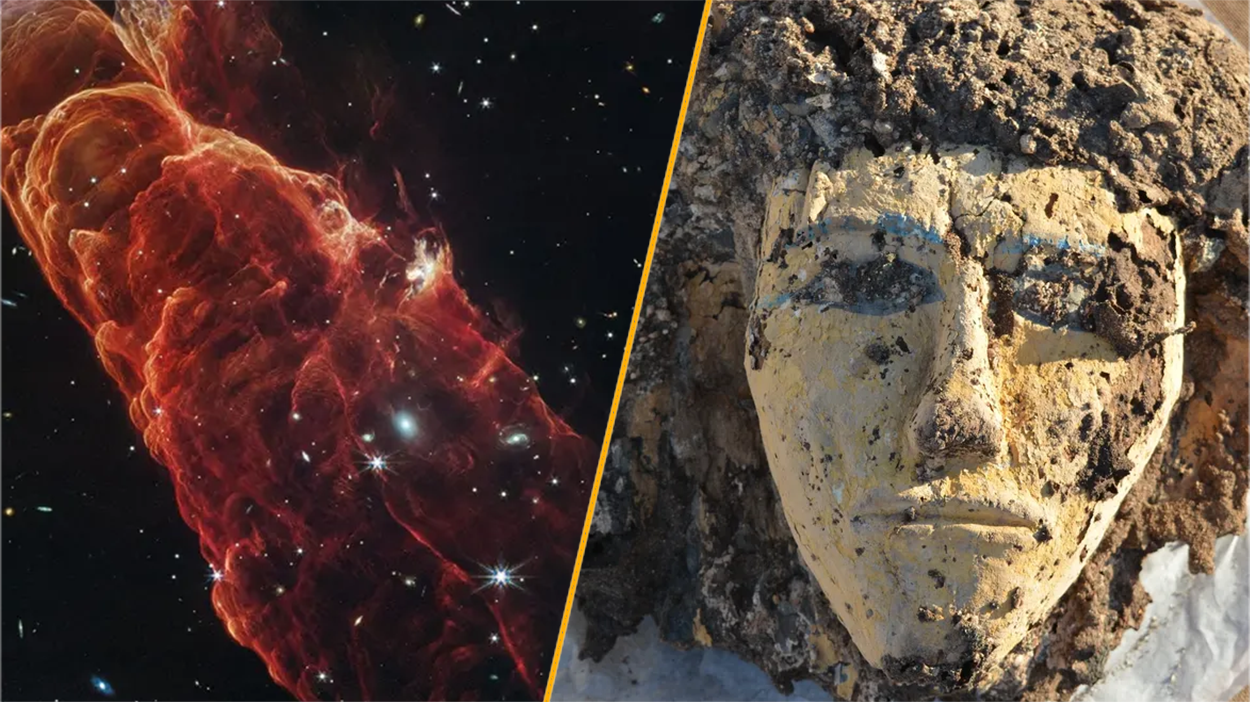
It’s been an exceptional week for skywatchers, marked by mysterious sky spirals, the northern lights and, of course, this morning’s long-anticipated sunrise solar eclipse.
On Monday (March 24), a giant vortex of light was seen floating across the night sky in Europe. But while many speculated that it was the work of aliens, the ethereal light show was actually caused by a dying SpaceX rocket, which was preparing to crash back to Earth after delivering “secret cargo” into orbit around our planet.
Auroras also lit up the skies across several northern U.S. states this week after a large hole in the sun’s atmosphere sent streams of charged particles toward Earth, creating a moderate geomagnetic storm.
But the main event this week has been today’s (March 29) partial solar eclipse. Between 4:50 a.m. and 8:43 a.m. EDT, the moon will roll in front of the sun, partially obscuring it as if a large bite had been taken out of our nearest star. The exact timings vary by location, and the eclipse will be visible in only 13 U.S. states, mostly in the Northeast.
NASA has released a map showing where and when to view the eclipse, and if you can’t see it from your location, you can watch the event online. If the eclipse is visible from where you live, it is important to wear appropriate safety glasses when you observe it, as looking directly at a partial solar eclipse can damage your eyes.
Ancient pyramids yield new surprises
Archaeologists long believed that the ancient pyramids of Egypt and Sudan were reserved for the highest echelons of society. But new research from a site called Tombos, which the Egyptians established in what is now Sudan after their conquest of Nubia, has led some archaeologists to question this theory.
Wealthy individuals were buried at Tombos, in tombs with small pyramids built above them. However, an analysis of the bones of 110 skeletons found at these burial sites suggests that many of the people buried in these pyramids performed significant amounts of heavy labor — an unlikely activity for high-status individuals at the time. As a result, the researchers concluded that lower-class laborers may have been buried alongside the elite in these famous ancient structures.
Discover more archaeology news
—Tumaco-Tolita gold figurine: A 2,000-year-old statue with a ‘fancy nose ornament’ from a vanished South American culture
—Human sacrifices found in a Bronze Age tomb in Turkey were mostly teenage girls
—’Exceptional’ hoard of 800 Iron Age artifacts found mysteriously burned and buried in UK field
Life’s Little Mysteries
Many pet owners claim that their furry friends can understand at least some human language. We are increasingly learning about the similarities between the communication styles of animals and humans — but can they really learn to speak our language?
Ancient organism baffles scientists
Scientists have discovered that a bizarre ancient life-form, once thought to be a type of fungus, might belong to a totally unknown branch of the tree of life.
The organism, named Prototaxites, lived around 420 million to 375 million years ago and resembled branchless, cylindrical tree trunks. They are considered by many to be the first giant organisms to grow on land, reaching up to 26 feet (8 meters) in height and 3 feet (1 m) in diameter.
Previous chemical analysis showed that these organisms likely fed off of dead and decaying organisms, just like many fungi do today. However, new research revealed that the organism’s internal structure is very different from anything we see in modern fungi today.
What’s more, its cells do not appear to contain chitin, a fundamental building block of fungal cell walls and a hallmark of the fungal kingdom. Instead, they contain chemicals similar to the woody lignin found in the bark and stems of plants. Thus, the researchers concluded that these strange organisms may belong to a previously unrecognized branch of the tree of life.
Discover more life on Earth news
—Scientists thought sharks didn’t make sounds — until this accidental discovery
—Scientists discover new 15 million-year old fish with last meal fossilized inside its stomach
—’Exquisitely preserved’ ginormous claws from Mongolia reveal strange evolution in dinosaurs
Also in science news this week
—Current AI models a ‘dead end’ for human-level intelligence, scientists agree
—Silent X chromosome genes ‘reawaken’ in older females, perhaps boosting brain power, study finds
—Why modern humans have smaller faces than Neanderthals and chimpanzees
—Never-before-seen chain of volcanoes discovered hiding near the Cook Islands
Science Spotlight
Between taking classes and considering college admissions, high-school junior Julian Shapiro is an independent astronomer with a keen interest in supernova remnants and planetary nebulas. However, in his quest to find debris from exploding stars, Shapiro came across something even more spectacular: the ghostly echo of a long-lost black hole almost twice the width of the Milky Way.
Long after black holes sputter out of existence, the gas clouds that surround them glow with leftover radiation, like wisps of smoke rising from an extinguished flame. These cosmic ghosts are known as “light echoes,” and it is one such echo that Shapiro spotted while sifting through data from the Dark Energy Camera at the Cerro Tololo Inter-American Observatory in Chile.
According to Shapiro’s calculations, the light echo measures about 150,000 to 250,000 light-years in diameter — between 1.5 and two times the width of our entire galaxy. If his estimates hold up, the discovery could mark the largest such light echo ever discovered.
“It was a real surprise to stumble upon this,” Shapiro told Live Science.
Something for the weekend
If you’re looking for something a little longer to read over the weekend, here are some of the best long reads, book excerpts and interviews published this week.
—‘We will fight for him’: Author John Green meets Henry Reider, a young tuberculosis patient with drug-resistant disease
—Scientists unveil new type of ‘time crystal’ that defies our traditional understanding of time and motion
—Brain aging accelerates dramatically around age 44 — could ketone supplements help?
Science in pictures
NASA’s James Webb Space Telescope snapped a spectacular image of an outflow of hot gas pouring from a newborn star in what has been dubbed a “cosmic tornado.”
The outflow, situated about 625 light-years from Earth in the constellation Chamaeleon, is known as a Herbig-Haro object. These objects occur when jets of ionized gas are ejected from newborn stars and collide with the surrounding interstellar material.
This particular Herbig-Haro object was discovered in 2006 but has never been seen in such great detail.
Want more science news? Follow our Live Science WhatsApp Channel for the latest discoveries as they happen. It’s the best way to get our expert reporting on the go, but if you don’t use WhatsApp we’re also on Facebook, X (formerly Twitter), Flipboard, Instagram, TikTok, Bluesky and LinkedIn.
Premium IPTV Experience with line4k
Experience the ultimate entertainment with our premium IPTV service. Watch your favorite channels, movies, and sports events in stunning 4K quality. Enjoy seamless streaming with zero buffering and access to over 10,000+ channels worldwide.

















